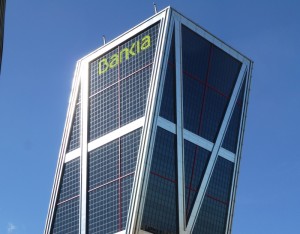Bankia: Capital comeback
Bankia made a spectacular return to the Tier 2 market on 13 May just a year after junior bondholders were bailed in following its bail-out in 2012. Here, Fernando Cuesta, head of funding at Bankia, and Vincent Hoarau, head of FIG syndicate at Crédit Agricole CIB, discuss the preprations for and execution of the Spanish bank’s comeback trade.
Issuer: Bankia SA Issue ratings: B- (S&P)/B+ (Fitch) Security description: Dated subordinated, Tier 2 Format: RegS Issue size: Eu1bn Tenor: 10 year non-call five Settlement: 22 May 2014 Maturity: 22 May 2024 First call date: 22 May 2019 Re-offer spread: 316bp over mid-swaps Coupon: 4% Re-offer yield: 4% Re-offer price: 100% Bookrunners: BAML, Bankia, Barclays, Crédit Agricole CIB, Goldman Sachs Distribution:UK & Ireland 46%, Iberia 14%, US offshore 12%, France 10%, Germany & Austria 7%, Switzerland 4%, Italy 2%, Benelux 2%, Asia 2%, others 1%.Investment funds 58%, hedge funds 23%, banks 12%, insurance companies and pension funds 3%.

This is a major subordinated benchmark transaction after the crisis and restructuring of BFA/Bankia Group. What are the main takeaways of this landmark trade for the issuer?
Fernando Cuesta, Bankia: Following the Eu1bn five year senior unsecured bond executed in January, we decided to take advantage of the strong market appetite for southern European credits in order to start building up our Tier 2 capital buffer — prior to the deal Bankia had no outstanding subordinated debt after the restructuring process conducted in the previous months.
The transaction is the third Tier 2 bond from a Spanish issuer in the last two years, following CaixaBank (Eu750m in October 2013) and BBVA (Eu1.5bn this April), both in 10NC5 format.
This transaction represents a big success for Bankia, further restoring investor confidence by continuing to rebuild its presence in the capital markets.
What was the rationale for the issue?
Cuesta, Bankia: The transaction represents a further step in the normalisation of the bank, and it allows Bankia to build up the new capital requirements set under Basel III. Up to now Bankia’s capital structure was mainly made up of equity, which is not the most efficient structure considering the new bank capital regulation.
This transaction improves the bank’s capital position: Bankia’s Basel III total capital ratio increases by 103bp, moving from 11.29% at the end of March to 12.32%.
You did not execute a global roadshow prior to the transaction. Why was this?
Cuesta, Bankia: We decided to go for a smooth two day execution instead of a global roadshow in line with recent Tier 2 deals, leveraging off good market conditions and the recent credit update roadshow completed after our 1Q14 results. A global investor call was organised for Monday, 12 May, with the Group CFO hosting it and over 70 investors participating. The investor call attendance was supportive enough to open books on Tuesday, 13 May.
Vincent Hoarau, Crédit Agricole CIB: The level of participation of international investors is clear evidence that the absence of a global roadshow did not harm the transaction at all. The issuer was very well prepared and the global investor call was sufficient. Some 85% of the total was distributed outside the Iberian peninsula and the level of granularity in the order-book was exceptional.
Why was a 10NC5 structure chosen?
Cuesta, Bankia: The structure is very well known on the investor community side, and from a regulatory point of view it is more efficient, as the issuer can avoid disqualification of 20% per year in the last five years.
Many investors expressed their preference for a standard maturity, in order to easily compare value versus other credits.
Hoarau, CACIB: Yields and coupon levels have dropped significantly, but over time there is room for spread improvement and further convergence, I think. The situation in Spain is improving; peripheral names are en vogue. The imbalance in the demand/supply/redemption dynamic predominates. So I would understand the risk implied by locking in a spread at the current level for a longer than necessary period from a regulatory standpoint. And as Fernando rightly said, the 10NC5 structure is very well established.
How did the pricing and order book develop?
Cuesta, Bankia: After announcing the mandate and holding the global investor call on 12 May, feedback was collected with indications of interest of around Eu800m. We then decided to launch the transaction with initial price thoughts of the low 4s on Tuesday, 13 May at 8.20am London time.
The book grew quickly and exceeded Eu2bn in roughly an hour. At 11.05am, with demand already exceeding Eu3.5bn, guidance was revised to 4%-4.125%. The book closed with total demand above Eu4bn — very well balanced between hedge funds and real money accounts — and more than 260 investors participating, enabling Bankia to price at a yield of 4.0%.
What factors influenced the approach to pricing? What are the main reference points you and syndicate banks looked at to determine the appropriate level?
Cuesta, Bankia: Our main reference points were other Spanish euro Tier 2 secondaries. Starting from there we calculated Bankia differentials to our peers in senior, and then added it to the aforementioned Tier 2 levels. This implied at the time a fair value of around mid-swaps plus 300bp. We considered a new issue premium of 15bp was fair enough, leading to the final price of mid-swaps plus 316.6bp.
Hoarau, CACIB: Indeed. At the time of the launch, CaixaBank senior unsecured outstanding May 2018s were trading in the context of mid-swaps plus 75bp, while Bankia January 2019s were around 160bp. This implied roughly 80bp of credit spread differential between the two signatures. In the Tier 2 segment, CaixaBank 5% November 2023s were trading around the 215bp mark. Adding a few basis points for the curve extension led to a fair value of around 300bp.
For what it is worth, we also looked at the CDS market and the credit spread differential there was tighter, with BBVA around 125 and Bankia around 195. But we were not convinced about the meaningfulness of having CDS levels as reference points.
In hindsight, would you have done anything differently?
Cuesta, Bankia: We were extremely happy with the result of the transaction. Timing was key, as market conditions became more volatile shortly after we priced the transaction. Having a Eu4bn book to cover a Eu1bn transaction is never easy, and made the allocation process complicated. Some investors could not be satisfied in their final takes. We always try to learn from every execution in order to be as fair as possible with them during this process.
Hoarau, CACIB: Within syndicate, we considered the marketing of the deal on a mid-swap spread basis. But given where the five year swap rate was ahead of the bookbuilding phase we thought marketing on a yield basis was much more appropriate and looked more appealing. As outlined before by Fernando, we started bookbuilding at the low 4s IPTs and priced the deal at a coupon of 4% versus a re-offer price of 100%. I think this was decisive in the marketing process. It also offered additional room to tighten the spread versus swaps given the nature of the demand.

